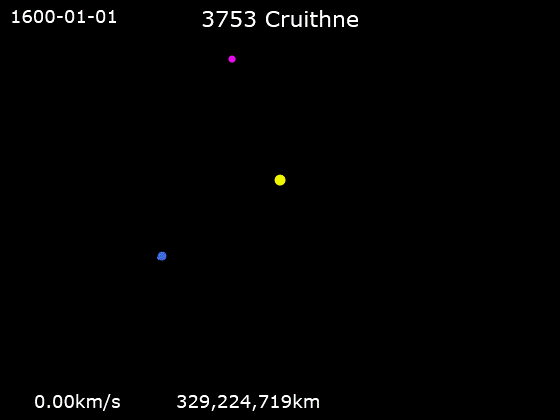|
Earth Trojan
An Earth trojan is an asteroid that orbits the Sun in the vicinity of the Earth–Sun Lagrangian points (leading 60°) or (trailing 60°), thus having an orbit similar to Earth's. Only two Earth trojans have so far been discovered. The name "trojan" was first used in 1906 for the Jupiter trojans, the asteroids that were observed near the Lagrangian points of Jupiter's orbit. Members (leading) * : A 300-metre diameter asteroid, discovered using the Wide-field Infrared Survey Explorer (WISE) satellite in January 2010. * : Discovered by the Pan-STARRS survey in December 2020 and later recognized as an Earth trojan in January 2021. (trailing) * No known objects are currently thought to be trojans of Earth. Searches An Earth-based search for objects was conducted in 1994, covering 0.35 square degrees of sky, under poor observing conditions. Received 24 November 1997; revised 13 April 1998. That search failed to detect any objects: : ... [...More Info...] [...Related Items...] OR: [Wikipedia] [Google] [Baidu] |
Lagrangian Point
In celestial mechanics, the Lagrange points (; also Lagrangian points or libration points) are points of equilibrium for small-mass objects under the influence of two massive orbiting bodies. Mathematically, this involves the solution of the restricted three-body problem in which two bodies are far more massive than the third. Normally, the two massive bodies exert an unbalanced gravitational force at a point, altering the orbit of whatever is at that point. At the Lagrange points, the gravitational forces of the two large bodies and the centrifugal force balance each other. This can make Lagrange points an excellent location for satellites, as few orbit corrections are needed to maintain the desired orbit. Small objects placed in orbit at Lagrange points are in equilibrium in at least two directions relative to the center of mass of the large bodies. For any combination of two orbital bodies there are five Lagrange points, L1 to L5, all in the orbital plane of the two lar ... [...More Info...] [...Related Items...] OR: [Wikipedia] [Google] [Baidu] |
Hayabusa2
is an asteroid sample-return mission operated by the Japanese state space agency JAXA. It is a successor to the ''Hayabusa'' mission, which returned asteroid samples for the first time in June 2010. ''Hayabusa2'' was launched on 3 December 2014 and rendezvoused in space with near-Earth asteroid 162173 Ryugu on 27 June 2018. It surveyed the asteroid for a year and a half and took samples. It left the asteroid in November 2019 and returned the samples to Earth on 5 December 2020 UTC. Its mission has now been extended through at least 2031, when it will rendezvous with the small, rapidly-rotating asteroid . ''Hayabusa2'' carries multiple science payloads for remote sensing and sampling, and four small rovers to investigate the asteroid surface and analyze the environmental and geological context of the samples collected. Mission overview Asteroid 162173 Ryugu (formerly designated ) is a primitive carbonaceous near-Earth asteroid. Carbonaceous asteroids are thought to p ... [...More Info...] [...Related Items...] OR: [Wikipedia] [Google] [Baidu] |
3753 Cruithne
3753 Cruithne is a Q-type, Aten asteroid in orbit around the Sun in 1:1 orbital resonance with Earth, making it a co-orbital object. It is an asteroid that, relative to Earth, orbits the Sun in a bean-shaped orbit that effectively describes a horseshoe, and that can change into a quasi-satellite orbit. Cruithne does not orbit Earth and at times it is on the other side of the Sun, placing Cruithne well outside of Earth's Hill sphere. Its orbit takes it near the orbit of Mercury and outside the orbit of Mars. Cruithne orbits the Sun in about one Earth year, but it takes 770 years for the series to complete a horseshoe-shaped movement around Earth. The name ''Cruithne'' is from Irish and refers to the early Picts (Old Irish: ''Cruthin'') in the ''Annals of Ulster''Cruithne: Asteroid 3753 . Western Washington University Planetarium ... [...More Info...] [...Related Items...] OR: [Wikipedia] [Google] [Baidu] |
Libration
In lunar astronomy, libration is the wagging or wavering of the Moon perceived by Earth-bound observers and caused by changes in their perspective. It permits an observer to see slightly different hemispheres of the surface at different times. It is similar in both cause and effect to the changes in the Moon's apparent size due to changes in distance. It is caused by three mechanisms detailed below, two of which cause a relatively tiny physical libration via tidal forces exerted by the Earth. Such true librations are known as well for other moons with locked rotation. The quite different phenomenon of a trojan asteroid's movement has been called ''Trojan libration''; and ''Trojan libration point'' means Lagrangian point. Lunar libration The Moon keeps one hemisphere of itself facing the Earth, due to tidal locking. Therefore, the first view of the far side of the Moon was not possible until the Soviet probe Luna 3 reached the Moon on October 7, 1959, and further lunar exp ... [...More Info...] [...Related Items...] OR: [Wikipedia] [Google] [Baidu] |



